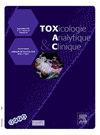Oral fluid analysis by LC-MS/MS: Comparison between drivers tested in random checks and after an electro/trance festival
IF 1.8
Q4 TOXICOLOGY
引用次数: 0
Abstract
Aim
To compare substances consumed by 2 populations of drivers – electro/trance festival (teknival) goers and drivers tested on random checks – by analyzing oral fluid samples collected on FLOQswabs™ devices.
To assess trends in new psychoactive substance (NPS) consumption during electro/trance music events such as teknival.
Method
Following driving checks during a teknival in the summer of 2024, our laboratory received 68 FLOQswabs™ samples for confirmatory analysis under French regulations. The first qualitative analysis, performed by liquid chromatography coupled to tandem mass spectrometry (LC-MS/MS), targeted amphetamine, methamphetamine, MDA, MDMA, MDEA, morphine, 6-monoacteylmorphine (6-MAM), cocaine, benzoylecgonine (BZE) and delta-9-tetrahydrocannabinol (THC). The previously reported protocol was implemented, according to the legal thresholds (Romeuf, Toxac, 2023, 35, 124–132). With the same injection, cannabidiol (CBD) and hexahydrocannabinol (HHC) were also targeted. In a second injection, unknown NPS screening was carried out by LC-MS/MS. The same methodology was applied to a representative population of 68 oral fluid samples collected on the same device during classic random checks for driving under influence of drugs.
Results
Sixty-six teknival samples were positive for at least one substance listed in the regulations, as were 64 from the random checks. Concerning cannabinoids, THC and CBD were more often detected in control samples (80.9% and 42.6%, respectively) than in teknival samples (61.8% and 26.5%). Morphine and 6-MAM were detected in only 1 control sample. Cocaine was systematically associated with its metabolite, BZE, with higher prevalence in teknival samples (44.1%) than in control samples (27.9%). Likewise, amphetamines, and particularly MDMA, were detected in 42.6% of teknival samples but in only 13.0% of control samples. On NPS analysis, ketamine was the most frequently detected substance in both populations, with higher prevalence in teknival samples (61.8%) than in controls (19.1%). In 98.0% of cases, ketamine was associated with at least one other substance. Few NPSs were found in the control population, with only diphenidine and HHC detected, in 1 case each; conversely, in the teknival population, dimethyltryptamine (DMT) and LSD were detected in 17.6% and 11.7% of cases, respectively. X-MMC and the benzofuran x-APB were identified in 2 cases each.
Conclusion
As expected, almost all swabs were positive for least at one substance, as confirmation is only required when the first oral fluid test by immunoassay is positive.
In both study populations, THC was the most frequently consumed substance. Cocaine and MDMA were consumed more frequently in the teknival context. Ketamine, which was detected in both populations, is one of the substances most commonly used in partying, particularly in combination with other substances (cocaine, amphetamine, MDMA or x-MMC). These various combinations enable specific effects to be obtained, such as sociability or managing come-down from other psychoactive substances. DMT and LSD were systematically co-consumed, but detected only in teknival attendees, in a non-negligeable proportion. These substances are hallucinogens, characteristic of alternative party settings. X-MMC, x-APB, HHC and diphenidine were detected in isolated cases, highlighting active but marginal consumption. A trend for NPS consumption may be suspected from the present data, but a larger-scale study would be necessary to assess prevalence of NPS in regular drivers. It is therefore important to note that, as required by the law, only drivers testing positive on initial oral fluid screening are required to provide a second sample (on a swab) for confirmation. Current screening tests are not able to detect substances such as LSD, DMT or ketamine, and are therefore interpreted as negative, so that other potential compounds go undetected.
LC-MS/MS分析:随机检查和电/恍惚节后驾驶员的比较
目的通过分析在FLOQswabs™设备上收集的口腔液体样本,比较两类驾驶员(电子/恍惚节(技术节)观众和随机检查的驾驶员)消耗的物质。评估新精神活性物质(NPS)在电子/恍惚音乐活动(如teknival)中的消费趋势。方法在2024年夏季的一次技术检查中,我们的实验室收到68份FLOQswabs™样本,根据法国规定进行验证性分析。第一次定性分析采用液相色谱-串联质谱联用(LC-MS/MS)进行,目标是安非他明、甲基苯丙胺、MDA、MDMA、MDEA、吗啡、6-单乙酰吗啡(6-MAM)、可卡因、苯甲酰茶碱(BZE)和δ -9-四氢大麻酚(THC)。根据法律阈值,先前报告的协议得到了实施(Romeuf, Toxac, 2023,35,124 - 132)。同样的注射,大麻二酚(CBD)和六氢大麻酚(HHC)也被靶向。在第二次注射中,通过LC-MS/MS进行未知NPS筛选。同样的方法应用于68个口腔液体样本的代表性人群,这些样本是在传统的药物影响下驾驶随机检查期间通过同一装置收集的。结果66份技术样品中检出至少一种规定物质,64份样品中检出至少一种规定物质。在大麻素方面,对照样品中THC和CBD的检出率分别为80.9%和42.6%,而技术样品中THC和CBD的检出率分别为61.8%和26.5%。仅在1份对照样品中检测到吗啡和6-MAM。可卡因与其代谢物BZE系统相关,在技术样品中的患病率(44.1%)高于对照样品(27.9%)。同样,在42.6%的技术样品中检测到安非他明,特别是MDMA,但在对照样品中仅检测到13.0%。在NPS分析中,氯胺酮是两个人群中最常检测到的物质,在技术样品中的患病率(61.8%)高于对照组(19.1%)。在98.0%的病例中,氯胺酮与至少一种其他物质有关。对照人群NPSs检出较少,仅检出苯苯胺和HHC,各1例;相反,在青少年人群中,二甲基色胺(DMT)和LSD分别在17.6%和11.7%的病例中检测到。X-MMC和苯并呋喃x-APB各2例。结论正如预期的那样,几乎所有的拭子至少对一种物质呈阳性,只有当第一次口服液免疫试验呈阳性时才需要确认。在这两个研究人群中,四氢大麻酚是最常消费的物质。可卡因和摇头丸在高科技环境下消耗的频率更高。在这两个人群中都检测到氯胺酮,它是聚会中最常使用的物质之一,特别是与其他物质(可卡因、安非他命、摇头丸或x-MMC)混合使用时。这些不同的组合可以获得特定的效果,例如社交能力或控制其他精神活性物质的下降。DMT和LSD系统地共同消费,但仅在技术参与者中检测到,在不可忽略的比例。这些物质是致幻剂,是另类派对的特色。在个别病例中检出X-MMC、x-APB、HHC和苯苯苯胺,显示活跃但边际消费。从目前的数据可以推测出NPS的消费趋势,但需要进行更大规模的研究来评估NPS在普通司机中的流行程度。因此,必须指出,根据法律规定,只有在初步口腔液体筛查中检测呈阳性的驾驶员才需要提供第二份样本(用棉签)进行确认。目前的筛选试验无法检测到诸如LSD、DMT或氯胺酮等物质,因此被解释为阴性,从而无法检测到其他潜在化合物。
本文章由计算机程序翻译,如有差异,请以英文原文为准。
求助全文
约1分钟内获得全文
求助全文

 求助内容:
求助内容: 应助结果提醒方式:
应助结果提醒方式:


